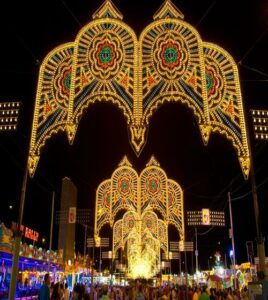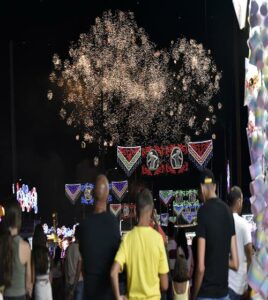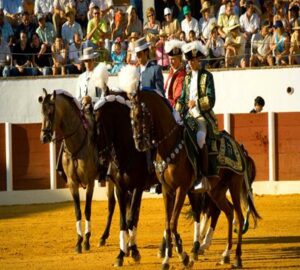The program of the Royal August Fair is wide and varied to try to satisfy the tastes of all attendees. On the eve of the fair, as usual before celebrations of these characteristics, the atmosphere is already preparing and the mood of the people predisposing, with acts as significant already in this city as the proclamation of the Peña Taurina “Los Cabales”, which is usually carried out by people related to the world of bullfighting: ranchers, bullfighters, bullfighting critics, etc. A few days later the official proclamation of the Royal Fair is pronounced, which usually falls on illustrious characters of the city, who are accompanied in this solemn event by the municipal authorities, the Councilor of the festivities, the media and a large number of citizens. Continuing with the activities that precede the fair, it is also worth mentioning the Pilgrimage of the Lord of Veronica, which begins every year with a rociera mass in the Plaza de Toros, which is followed by a procession that runs through different streets of the city until reaching the hermitage where that image so venerated by the people of Antequera is located.

The inauguration of the official lighting marks the beginning of the Royal Fair. From that night the city lives its festivities for a whole week, with multiple events aimed at the most varied public. For some years, as in Malaga, the fair is divided into two days: the “Day Fair” and the “Night Fair”. In the morning, people go to the premises of the urban area that associations and brotherhoods are responsible for conditioning for these dates, as well as to the booths of the fairground itself. At night, the party takes place only in the fairgrounds, located in the Parque del Norte since 2005, where the Municipal Booth and the rest of the Andalusian and youth booths, the fair attractions and the street stalls that arouse the curiosity of those who walk through the area. Over the course of the days, numerous shows contribute to the fun of citizens: musical performances, humorous performances, bullfights, exhibitions of horse hitches, activities aimed at children …, thus completing an agenda of the most varied and entertaining, which culminates with the explosion of fireworks on the last night of the Royal August Fair of Antequera.
ROYAL FAIR OF AUGUST 1. THE ROYAL AUGUST FAIR. A HISTORICAL INTRODUCTION.
1998 marked the 250th anniversary of the celebration in Antequera of the first Royal August Fair. Since then, the transformations suffered by this type of event have been so many, that even the word “fair” itself has lost its primitive meaning. In a trajectory that has its direct antecedent in the annual meetings of merchants and money changers – almost always propitiated by the Crown itself through the granting of a series of tax privileges, in order to achieve the economic reactivation of a certain region; the concept ends up being identified with that of “Fiesta”, after all kinds of amusements and popular shows are associated with it, which will be the ones that in the end, and after a long coexistence that reaches almost to this day, end up being imposed, converting what was originally a commercial and livestock market, into a program of social expansion that evolves according to the times. In 1748, Ferdinand VI, at the request of the Council of Antequera, granted for ten years the privilege of holding an annual fair between August 20 and 23, although only on the first day he enjoyed the tax exemptions that came with a concession of this kind. It is surprising, at first glance, how late the date, even more so when, due to its geographical location and commercial tradition – a distribution center for goods -, it seemed logical that Antequera had a fair for a long time before. but perhaps the special tax regime that the population permanently enjoyed – the exemption from the payment of alcabala, a tax on commercial exchange -, or the famous weekly market, agricultural and livestock, which every Monday, and since the early sixteenth century took place in the Plaza Alta, influenced so that it was not raised – that we know – the need to establish an annual fair. The truth is that, for more than two centuries, artisans and merchants went to sell their products at the fairs of Ronda, Écija, Jerez, Villamartín, Coin and Olvera. The origin of the August fair must be raised, therefore, in other coordinates; simply as one more of the series of privileges granted to the Wool Factory, in order to achieve greater commercialization of its manufactured products – cloths and cloths – suffocated by foreign competition, the weakness of the market they supplied and the structural deficiencies of the local craft sector. However, what was thought to be an expansion of the local wool market, came to cover, practically the same year of its creation, the rest of the commercial activities, especially the sale of livestock, lingerie, leather, footwear and silverware. In this sense, the August fair was the natural and direct heir of the weekly market to which we referred above, in a trance of disappearance for that time, and that since 1767 is recovered again by settling in the lands of the “real”, located then on either side of the Puerta de Estepa (finished rebuilding in the summer of 1998), between what is now the start of the Paseo and the Alameda to Estepa Street. In that place, and for four days a year, merchants, artisans and farmers from all over Andalusia installed their stalls. Above all, the merchants of Seville and Granada abounded, as well as the silversmiths from Cordoba, although there were also numerous farmers from the countryside of Córdoba and the mountains of Granada and the merchants from Antequera, who made up the “offer” of the fair.
As for the “demand”, nobility, bourgeoisie and wealthy classes consumed luxury items that were hardly found in the city in normal times, while the drapery market was composed of the peasants of the nearby areas, who directly or through merchants acquired clothes and clothing for the winter, at a time when, Still fresh the fruit of the last harvest, they still had enough cash. Until 1760, the fair developed uninterruptedly, without major incident; However, that year the first problems arose: in a phantom meeting of the Corporation – attended by only four councilors -, it was requested, to avoid “the serious inconveniences that have been experienced in the fair since it was put into practice”, its suppression. Such a request is not understood without taking into account what was reactionary and outdated in the Antequera Council, but its consequences sufficiently illustrate what happened between that date and 1768, when the previous decision was definitively revoked after a long and tense municipal session. 1768 was a key year for the subsequent fate of the Royal August Fair. After the first two terms of the royal concession, and after the controversy of 1760, the Council had to decide on the convenience of ratifying the nullity agreement or requesting the Crown to extend the Fair. The capitular acts of that year adequately report on what was undoubtedly the most contentious issue of all that the munícipes had dealt with in a long time. In the end, and after a close vote – six votes in favor of resuming the fair and four who continued to advocate its suppression -, the council’s notaries made public the ruling: … And having by us the scribes made regulation and comparison, it turns out by greater number of votes that the agreement of the city is that it is reported to be useful and combeniente the Fair, of which we attest … From 1768, and once the aforementioned difficulties were overcome, the Municipal Council intensified its control over the fair: circulation through the fairgrounds was prohibited and the places of sale were regulated, while the neighbors were forced to take care of the state of the streets of the “real”.
Finally, it is worth mentioning a fact that will later have special significance: it is in these years when the relationship between fair and party becomes closer. Indeed, the August fair quickly became one of the extraordinary dates that punctuated the year – Carnival, Corpus, San Juan, etc. – and in which the rigid structures of traditional life were temporarily shaken. For a society accustomed to living so close to death, with a spatial pressure – difficulty of communications, scarcity of travel – and social – influence of the church and religion – much more accentuated than today, it was necessary to take advantage of the opportunity offered by the presence in Antequera of people of all conditions and origins, to celebrate it with the means at their disposal. Thus, it may not seem strange that soon appeared associated with the fair shows and traditional amusements in parties, such as ribbons, dances and, especially, bulls, in a process that is currently in full force. However, unlike the bullfights that had been held in the city for almost three centuries, these will no longer have as a stage the Plaza Alta, nor those of San Sebastián or the Coso de San Francisco, but – in a feature of modernity -, a circular bullring, made of wood, armed in the square of Capuchinos, and where, each of the days of the fair, several steers were fought. In this way, at the end of the eighteenth century and the beginning of the nineteenth century the symbiosis between fair and party had been consummated: it was no longer understood that without masks, dances or bulls. It was the beginning of a story that comes down to us.

1.2. The nineteenth century: from “fair” to “party”.
Naturally, and throughout the nineteenth century, the August fair of Antequera was losing its character as a meeting place and exchange of goods, limiting the activity almost exclusively to the sale of livestock, and accentuating the recreational aspects and social expansion. From that date, the fair began to share events of other traditional festivals: bulls of Corpus Christi and patron saint festivities, dances and masks of Carnival; in addition to developing others that since then would be his own. Slower than customs, the official attitude to the celebration also changed. Although only from the last third of last century the Cabildo took a decidedly organizational position, it is true that its interventionism was changing its face: from limiting itself to dictating sides to ensure the collection of municipal rights and ensure the maintenance of public order, it became directly interested in the assembly of bullfighting shows – the new square was inaugurated in 1848 -, musicals and circuses. In some way, then, we can speak of “two” real fairs of August in the Antequera del Ochocientos: one during the first half, essentially livestock and barter, and another at the end of the century, closer to the motivations that, today, make up this type of celebration. As already mentioned, we have evidence that at least since 1816 the City Council of Antequera showed interest in the construction of a permanent square. According to a report of the city council of 1846 the construction of the square would serve as a revulsive of an August fair in decline. The square was inaugurated on August 28, 1848 by the right-handers José Redondo “Chiclanero” and Juan Pastor “Barbero” with bulls from the livestock of Picavea. In fact, when the Royal August Fair came to acquire the characteristics that would make it the great annual celebration of the city was from 1875, to the point of becoming one of the most important festivals of the Andalusia of the Restoration, both for the animation of the celebrations and for the economic activity generated by the cattle fair.
The twentieth century: towards the conformation of the current fair.
Despite the empowerment of the recreational aspects, the truth is that throughout that period, and at least until the Civil War, the cattle market continued to be one of the capital events of the fair along with the bullfight; Because livestock was with agriculture the great source of wealth of this municipality and its region. All this great event that constituted the cattle market was gradually entering into crisis in the decade of the twenties by the development of the automobile and the modern machine that will end up displacing the animal force. The fair is transformed and what was the foundation and origin of it, the cattle market, loses its importance and bullfighting and football become the main attractions. After the painful hiatus imposed by the Civil War, the fair was held again in 1939. Of course, in the midst of a calamitous economic situation, the efforts of normality that from the first Francoist municipalities wanted to transfer to the population collided head-on with the situation of penury and hunger that, as in the rest of Spain, affected many of the antequeranos of that time. The Fair continued with the usual components since the beginning of the century: next to the bulls the cattle market, the sport and, as a culmination, the fireworks.

As economic conditions improved, the recreational aspect of the Fair increased: the “pots” in the old football field and the circuses and other shows in the “plain of the barracks”; also, after the restrictions, electric lighting became another of the characteristic elements of the events programmed by the City Council. In the sixties something similar happened to what had happened at the beginning of the century: the now definitive modernization of the agricultural sector began to bring to the fairs the latest advances in agricultural technology. But times were not only beginning to be different in this regard. Franco’s developmentalism did not mean political homogenization with the outside, but social and economic homogenization. It was then that the “queen of the parties” began to be chosen. Also the moment in which the sports specialties multiplied, while the music began to settle definitively in the fair. All this until at the beginning of the sixties the format of “great booth” was imposed, with first-row performances. Undoubtedly, the booth of the Peña los 20, in addition to playing the role of the then non-existent municipal booth, significantly marked the August Fair in that decade.
Contact:
Address: 29200 Antequera, Malaga
